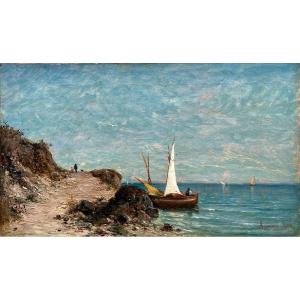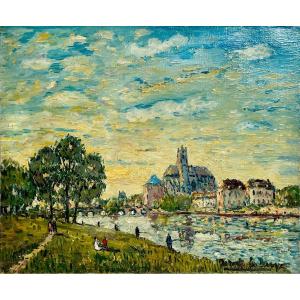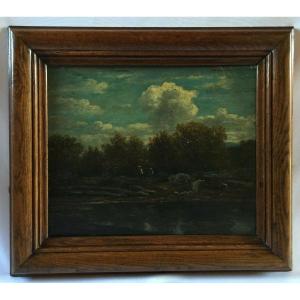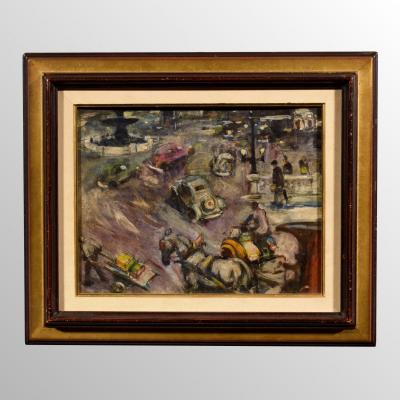Mingret, Louis-Joseph, known as José
Vitré, Ille-et-Vilaine, March 22, 1880 – Saint-Laurent-sur-Saône, Ain, opposite Mâcon, Saône-et-Loire, May 29, 1969
Sea of clouds over Lake Geneva – The Mont Blanc Massif seen from Colomby de Gex, Ain, 1919
Oil on canvas
Signed on the reverse of the stretcher, inscribed in drypoint, “José Mingret . 1919 - Le Mont Blanc vu du Colomby de Gex.”
H. 46.5 cm. / W. 56.2 cm.
Original carved and gilded wood frame with fine gold, designed and executed by the artist.
On the reverse, head-to-foot, a second mountain composition by the artist.
Work cleaned and varnished by a professional restorer.
--
This rare work by José Mingret depicts a striking Alpine panorama seen from the summit of the Colomby de Gex (Ain), which rises to 1,688 metres in the French Jura (it is the fourth highest peak in the Jura massif.). From this natural vantage point, the viewer overlooks a vast sea of clouds covering the Lake Geneva basin, above which the Mont Blanc massif emerges, bathed in a soft, rosy light at dusk.
The composition is built upon a carefully orchestrated progression of planes: in the foreground, stylised cloud masses rendered in undulating contours; beyond, the dark ridge of the Jura; and in the distance, the snow-capped peaks of Mont Blanc outlined against a luminous, subtly turbulent sky. The result is asynthesis of structural clarity and atmospheric depth.
The brushwork is dynamic and at times fragmented, with more pronounced impasto in the treatment of the clouds. The sky, painted in thin layers, displays delicate tonal shifts from rose to celadon green and pale blue. The contrast between the dark foreground ridges and the bright Alpine summits enhances the visual tension and spatial depth.
Painted in 1919, this work reflects Mingret’s deep engagement with mountain landscapes and expresses a contemplative sensibility rooted in direct observation of nature. It belongs to a mature period in which the artist achieves a compelling balance between naturalistic rendering and symbolic evocation. The original frame, sculpted and gilded by Mingret himself, reinforces the aesthetic coherence of the piece, underscoring his holistic vision of the work of art.
--
Mingret, Louis-Joseph, known as José
Vitré (Ille-et-Vilaine), March 22, 1880 – Saint-Laurent-sur-Saône (Ain), opposite Mâcon (Saône-et-Loire), May 29, 1969
Louis-Joseph Mingret, known as José, was a French painter born in Vitré (Ille-et-Vilaine), where his father, originally from Asnières-sur-Saône (Ain), served as registrar of mortgages. Gifted in drawing from an early age, he was educated in Pont-l’Évêque (Calvados) and later at the lycée in Le Mans (Sarthe). Though initially enrolled in law school at his father’s behest, he soon abandoned his legal studies to devote himself to painting.
Around 1900, he settled in Paris on boulevard Raspail and studied at the Académie Julian from 1903 to 1906 under Marcel Baschet (1862-1941), Henri Royer (1869-1938), and William Bouguereau (1825-1905). Little is known of his early work, but a few extant pieces already reveal a notable talent. On July 7, 1908, he married Lucie Gibier (1877-1957), a Parisian miniaturist, who throughout her life shielded him from practical concerns, enabling him to devote himself fully to his art.
From 1906 onward, José Mingret began exhibiting his works in various cities across France and abroad. During the First World War, he was declared unfit for service due to a chronic nervous condition, yet like many artists of his generation, he contributed to the war effort by painting scenes of daily life in the trenches and on the front. In the post-war years, he often left Paris and travelled extensively, especially in Italy, where he painted in Florence, the Aosta Valley, the Dolomites, and Venice. Passionate about both mountain painting and mountaineering, he regularly stayed in Menaggio (province of Como), on the shores of Lake Como, which served as his base for alpine excursions.
Despite these wide-ranging travels, Mingret remained deeply attached to the banks of the Saône. His dated works indicate frequent returns to Mâcon, where his parents had retired. In 1941, he left Paris to settle in Asnières-sur-Saône, in the house he had inherited from his father. There, he undertook a sustained study of the Saône landscapes that would become central to his artistic identity.
The death of Lucie Mingret in 1957 was a severe blow. Soon there after, his health declined, and he was admitted to the hospital in Saint-Laurent-sur-Saône (Ain), opposite Mâcon, where he died on May 29, 1969.
--
Bibliography
Delaplace,Yves, José Mingret, 1880-1969, Macon,Museum, 2013 (128 pp.).
--






















 Le Magazine de PROANTIC
Le Magazine de PROANTIC TRÉSORS Magazine
TRÉSORS Magazine Rivista Artiquariato
Rivista Artiquariato
